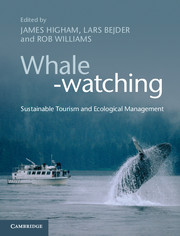Book contents
- Frontmatter
- Dedication
- Contents
- Acknowledgements
- List of contributors
- List of abbreviations
- 1 Tourism, cetaceans and sustainable development
- Part I The historical and contemporary contexts
- Part II Human dimensions of whale-watching
- Part III Ecological dimensions of whale-watching
- Part IV Sustainable management: insights and issues
- 18 The socioeconomic, educational and legal aspects of whale-watching
- 19 Vigilance, resilience and failures of science and management
- 20 Insights from agent-based modelling to simulate whale-watching tours
- 21 Cetacean-watching in developing countries
- 22 Kaikoura (New Zealand)
- 23 Management of dusky dolphin tourism at bKaikoura, New Zealand
- 24 Save the whales Part II
- 25 Time to rethink
- Index
- Plate Section
- References
23 - Management of dusky dolphin tourism at bKaikoura, New Zealand
from Part IV - Sustainable management: insights and issues
Published online by Cambridge University Press: 05 April 2014
- Frontmatter
- Dedication
- Contents
- Acknowledgements
- List of contributors
- List of abbreviations
- 1 Tourism, cetaceans and sustainable development
- Part I The historical and contemporary contexts
- Part II Human dimensions of whale-watching
- Part III Ecological dimensions of whale-watching
- Part IV Sustainable management: insights and issues
- 18 The socioeconomic, educational and legal aspects of whale-watching
- 19 Vigilance, resilience and failures of science and management
- 20 Insights from agent-based modelling to simulate whale-watching tours
- 21 Cetacean-watching in developing countries
- 22 Kaikoura (New Zealand)
- 23 Management of dusky dolphin tourism at bKaikoura, New Zealand
- 24 Save the whales Part II
- 25 Time to rethink
- Index
- Plate Section
- References
Summary
Introduction
The desire to view and interact with animals in their natural environment has driven strong growth of cetacean-based tourism since its inception in California in the 1950s. After years of steady growth in the US, the economic potential of the cetacean-watching tourism industry was recognized worldwide (see Chapter 1). In the early years of the industry, cetacean-based tourism developed with little or no management, regulation or oversight (Hoyt, 2008). Legislation to protect cetaceans was often designed to limit the effects of whaling and harpoons, not tourism boats and cameras. Perhaps as a consequence, little consideration was given to the effects of tourism on the target species. It was perceived to be less harmful than the alternative, and therefore additional protection was not needed (O’Connor et al., 2009).
Growth of cetacean tourism has led to increasing concerns about the effects of repeated close encounters with tour boats on the health of the target animals and the sustainability of the industry (Bejder & Lusseau, 2008; Parsons, 2012). Researchers have described a host of short-term reactions by cetaceans to the presence of boats, including changes in behaviour, movement, respiration, dive characteristics, habitat use, communication and group cohesion (e.g. Au & Green, 2000; Barr & Slooten, 1999; Bejder et al. 2006a, 2006b; Buckstaff, 2004; Constantine, 2001; Dans et al., 2008; Erbe, 2002; Gordon et al., 1992; Jahoda et al., 2003; Lusseau, 2006; Nowacek et al., 2001; Scarpaci et al., 2000; Stensland & Berggren, 2007; Williams et al., 2002).
- Type
- Chapter
- Information
- Whale-watchingSustainable Tourism and Ecological Management, pp. 337 - 351Publisher: Cambridge University PressPrint publication year: 2014
References
- 3
- Cited by



